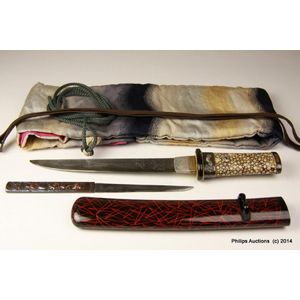Edo Period Japanese Tanto with Cloisonne Fuchi and Lacquer Scabbard
A fine Japanese tanto, Edo period (1603-1837), with a lacquered and patterned sharkskin hilt surmounted by a cloisonne fuchi, a black lacquered scabbard with red pine needle inclusions, the blade with samurai and geisha embellishments, signature and a faint poem, the removable kozuka with sea shell motifs and a signed blade. Knife lengths 28.5 cm. and 21 cm
You must be a subscriber, and be logged in to view price and dealer details.
Subscribe Now to view actual auction price for this item
When you subscribe, you have the option of setting the currency in which to display prices to $Au, $US, $NZ or Stg.
This item has been sold, and the description, image and price are for reference purposes only.
- Edo Period, Japan - The Edo period in Japan lasted from 1603 to 1868. During this time, Japan was ruled by the Tokugawa shogunate, a military government led by the Tokugawa family. The Edo period is characterized by a period of relative peace, stability, and economic growth, as well as by the development of a distinctive culture and society.
During the Edo period, the capital of Japan was moved from Kyoto to Edo (modern-day Tokyo), and the country became increasingly isolated from the rest of the world. The shogunate implemented strict policies to maintain control, including the restriction of foreign trade and travel. However, despite this isolation, the Edo period saw significant cultural and artistic development, including the emergence of the ukiyo-e woodblock print tradition, the growth of Kabuki theater, and the flourishing of a vibrant merchant culture.
The Edo period ended with the Meiji Restoration of 1868, which saw the collapse of the shogunate and the restoration of imperial rule.
This item has been included into following indexes:
Visually similar items

Pair of Kate Spade brown suede pumps, Mary Jane style, with patent leather detailing, square toe, size unknown approx 36, a/f, with original dust bag and box
Sold by
in
for
You can display prices in $Au, $US, $NZ or Stg.

Boxed sterling silver Georg Jenson cheese knife
Sold by
in
for
You can display prices in $Au, $US, $NZ or Stg.

Carved ivory figure of reclining noble with wine flask as pillow, 18 cm length
Sold by
in
for
You can display prices in $Au, $US, $NZ or Stg.

Boxed amber and gold plated cigarette holder Box marked Apex and genuine amber
Sold by
in
for
You can display prices in $Au, $US, $NZ or Stg.
